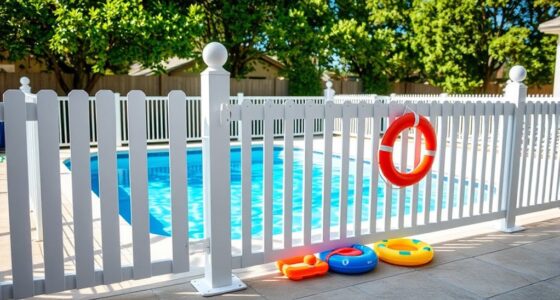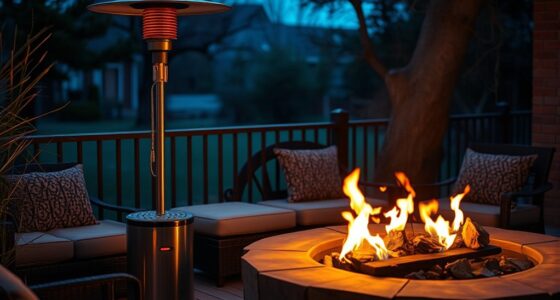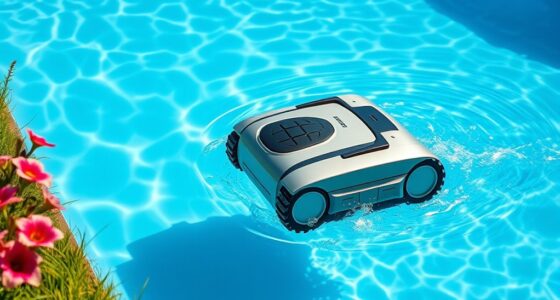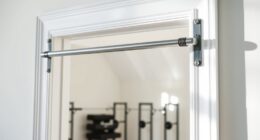Inflatable hot tubs are budget-friendly, portable, and easy to install, making them great for casual users or those short on space. However, they tend to last only 2 to 5 years and may require frequent repairs due to material wear. Built-in spas cost more upfront but last decades longer, offer advanced features, better energy efficiency, and durability. If you want to explore the detailed advantages and drawbacks, there’s more to discover below.
Key Takeaways
- Inflatable hot tubs are budget-friendly, portable, and easy to set up, but have a shorter lifespan and are more prone to damage.
- Built-in spas require higher initial investment and professional installation but offer durability and a longer lifespan.
- Inflatable models have simpler maintenance but are less energy-efficient and may struggle to retain heat in cold climates.
- Built-in spas provide advanced features, powerful jets, and customizable options for a premium relaxation experience.
- Overall, built-in spas are more cost-effective long-term due to their durability and energy efficiency despite higher upfront costs.
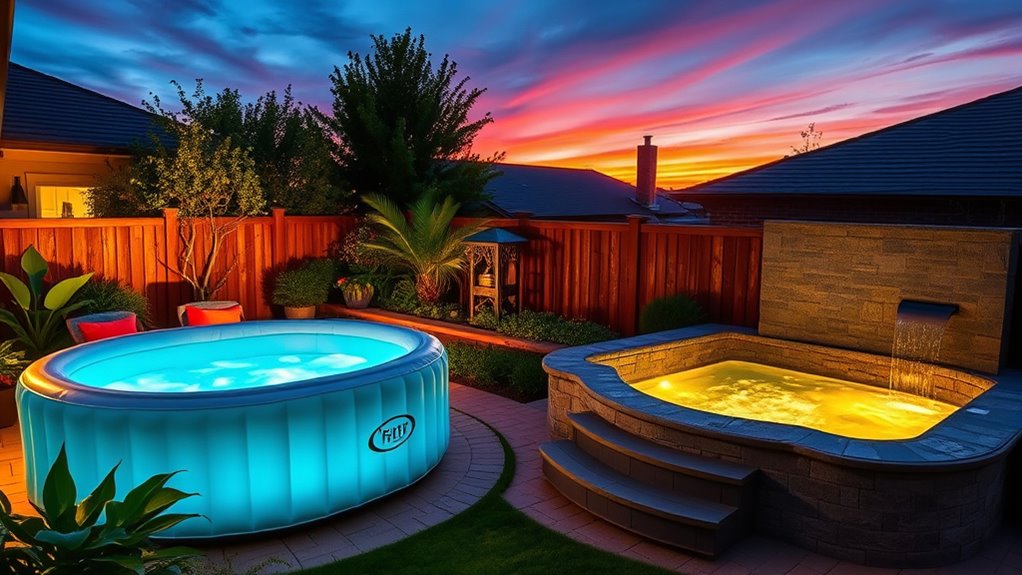
When choosing between inflatable hot tubs and built-in spas, it’s important to contemplate your budget, space, and how you plan to use your hot tub. Inflatable hot tubs are a budget-friendly option, costing considerably less upfront. They’re ideal if you want occasional relaxation without a big investment, as they don’t require professional installation or complex plumbing. You can set them up yourself in minutes, whether on a deck, patio, or even indoors, and easily store or move them when you don’t need them. This portability makes inflatable tubs flexible for seasonal use or limited outdoor space. Built-in spas, on the other hand, demand a higher initial investment. You’ll need professional help for installation, including site preparation, electrical wiring, and plumbing. Once installed, they become a permanent fixture, usually embedded into landscaping or decking, which limits mobility but offers a sleek, integrated look.
Inflatable hot tubs are affordable, portable, and easy to set up, ideal for occasional relaxation and limited outdoor space.
Durability and lifespan are important considerations. Inflatable hot tubs generally last between 2 to 5 years, depending on maintenance and usage. Their materials—PVC and nylon fabric—are prone to punctures, tears, and wear over time, which can lead to frequent repairs or replacements. Built-in spas are much sturdier, typically lasting 10 to 20 years or more. Constructed from durable acrylic shells and insulated cabinets, they resist weather damage and physical wear, making them a long-term investment. Although inflatable tubs are cheaper initially, their shorter lifespan and potential repair costs can offset those savings over time. Inflatables are also more susceptible to damage from sharp objects or rough handling, which can increase repair costs. Additionally, the maintenance requirements for inflatable models tend to be simpler, making them easier for casual users to manage.
When it comes to hydrotherapy features, built-in spas excel. They offer powerful pumps, numerous jets, advanced water features, and ergonomic seating, delivering superior massage and relaxation experiences. Inflatable models usually have fewer, lower-powered jets, providing a more basic bubbling or gentle massage effect. Their controls are simpler, with limited customization options, which can be sufficient for casual use but not ideal for therapeutic needs. Built-in spas also tend to include features like customizable lighting and water features, enhancing the overall experience. Their advanced features often justify the higher cost for users seeking a spa-like experience.
Energy efficiency is another key factor. Built-in spas are designed with thicker insulation and more efficient heating systems, consuming less energy to maintain water temperature. Inflatable hot tubs have thinner insulation, which causes them to heat water more slowly and struggle to hold heat, particularly in colder climates. This means higher energy bills over time, despite their lower initial cost. Overall, your choice depends on your priorities—whether you value affordability and flexibility or durability and premium features.
Frequently Asked Questions
How Long Does It Take to Install a Built-In Spa?
You’re wondering how long it takes to install a built-in spa. Typically, the process lasts several weeks to a few months, depending on site conditions and complexity. Expect excavation, plumbing, electrical work, and shell formation to take around 3 to 8 weeks. Finishing touches like decking and landscaping add another 1 to 4 weeks. Delays from weather or permits can extend the timeline, so plan accordingly.
Can Inflatable Hot Tubs Be Used Year-Round?
You can use inflatable hot tubs year-round if you take proper precautions. In cold weather, keep the water warm by maintaining heater operation, using insulated covers, and sheltering the tub from wind and snow. However, very low temperatures below 14°F can cause freezing damage, so it’s best to drain and store the tub in extreme cold. With careful planning, you can enjoy your inflatable hot tub throughout all seasons.
What Are the Energy Costs for Each Type?
You’ll find that inflatable hot tubs cost around $10 to $20 per month in electricity, depending on usage, insulation, and local rates, making them quite affordable. Built-in spas tend to cost more, usually between $30 and $50 or more monthly, because of larger volume and more jets. Proper insulation can markedly reduce costs for both, but overall, inflatable models are more budget-friendly for ongoing energy expenses.
Are Inflatable Hot Tubs Durable in Harsh Weather?
Think of your inflatable hot tub like a delicate sailboat in a storm—careful handling is key. While it can handle cold temperatures with features like Freeze Shield, harsh weather can cause tears, cracks, and reduce its lifespan to 3-7 years. Regular maintenance, proper placement, and winter protection help it withstand the elements, but it’s still more vulnerable than a built-in spa, which can last 20+ years.
How Easy Is It to Move a Built-In Spa?
Moving a built-in spa isn’t easy; it involves careful planning, specialized equipment, and often professional help. You need to assess its size, weight, and accessibility, then coordinate with a team to lift and transport it safely. Route planning is essential to avoid obstacles, and using tools like dollies, straps, or even cranes might be necessary. Overall, expect it to be a complex, labor-intensive process requiring safety precautions and expertise.
Conclusion
Choosing between an inflatable hot tub and a built-in spa is like selecting a vessel to carry your dreams of relaxation. An inflatable tub offers spontaneity and ease, representing the freedom to escape whenever you desire. A built-in spa symbolizes enduring comfort and stability, like a sanctuary you can always return to. Whichever you choose, remember it’s more than water—it’s a vessel for your moments of peace, connection, and renewal. Your perfect retreat awaits, ready to embrace you.


